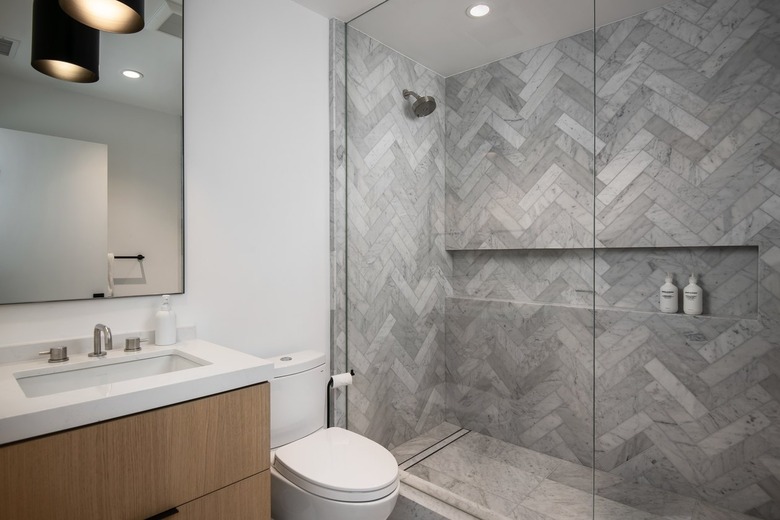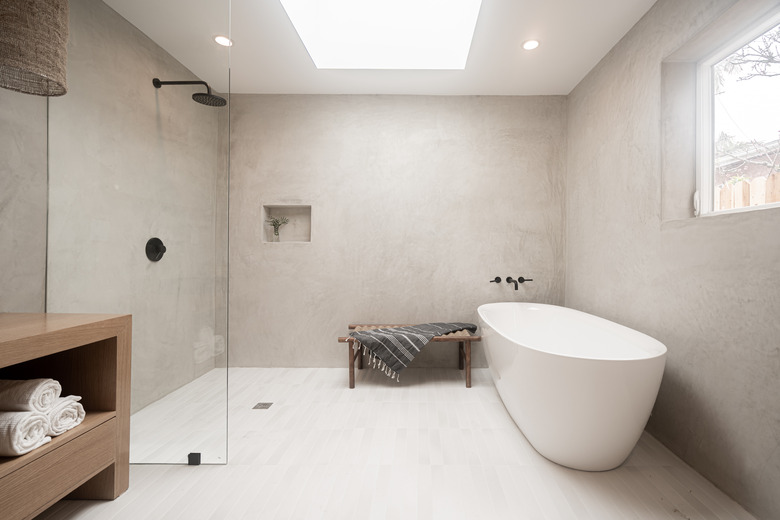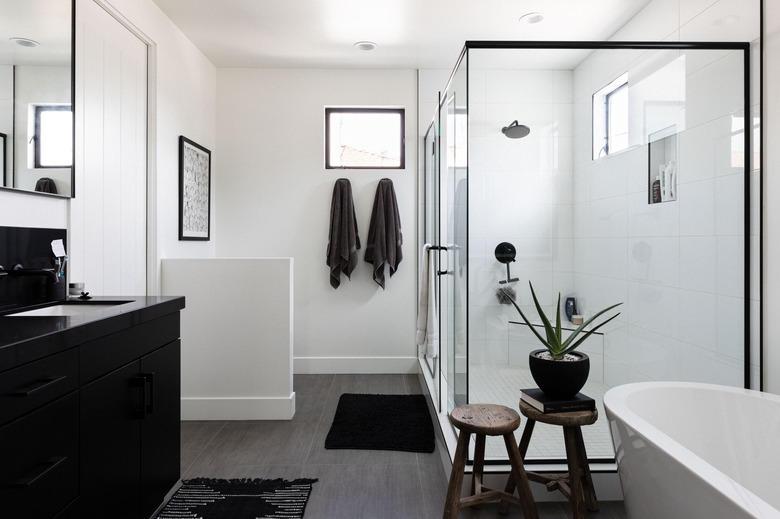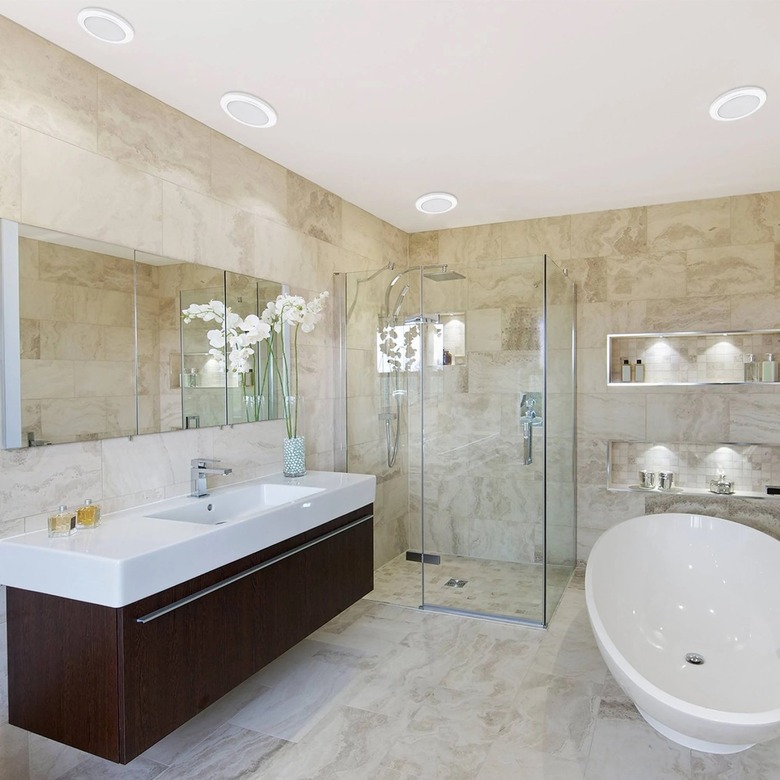Shower Light Fixture: A Homeowner's Starter Guide
We may receive a commission on purchases made from links.
At a bare minimum, the National Electrical Code requires one light fixture in every bathroom. You can fulfill this requirement by installing a shower light fixture. A bathroom has to be pretty small for a shower light fixture to provide adequate illumination, however, and most bathrooms have vanity lights, wall sconces or other types of lighting fixtures as well as the required ceiling fixture, so you often don't need light in the shower to make the building inspector happy.
Even so, it's always convenient to have a shower light fixture even if it isn't mounted on the ceiling. You can't just use any old fixture, though. All parts of the shower stall are subject to condensation and splashing from the shower head, and any lighting fixture you install on the shower wall must be rated for use in wet locations — in other words, waterproof.
Wet-Location vs. Damp-Location Lighting
Wet-Location vs. Damp-Location Lighting
Lighting fixtures can be rated for use in wet locations or damp locations, and the difference is in the quality of the seal between the protective cover and the light socket itself. Wet-location fixtures, designed to be in direct contact with water (typically from occasional spray or splashing) are completely sealed against moisture. These are the type of fixtures you normally find outside in locations that are completely exposed to rain and weather.
Damp-location fixtures can tolerate some contact with moisture but not prolonged contact and no direct contact with water. These are the type of fixtures you hang on a covered porch or deck. In a bathroom, the code allows you to use a damp-location fixture over the bathtub or just outside the shower but not inside the shower stall. Other light fixtures in the bathroom do not have to be rated for damp or wet locations as long as they are sufficiently far from the tub and shower.
Shower Light Fixture and GFCI Protection
Shower Light Fixture and GFCI Protection
The electrical code requires that all outlets in the bathroom have ground-fault circuit-interrupter (GFCI) protection, and according to the National Electrical Installation Standards, you can supply a bathroom with a single 20-amp circuit for both the electrical receptacles and the lights, provided that the circuit powers only that one bathroom. Even though the code requires all the receptacles to have GFCI protection, it doesn't require this for the lights, but the light fixture manufacturer might.
The easiest way to meet both the code requirements and those of the fixture manufacturer is to install a GFCI breaker in the panel for the bathroom circuit. When wiring a new-construction bathroom or a remodel, you can also fulfill both requirements by ensuring the first device on the circuit is a GFCI receptacle to which other devices downstream from the panel are connected. That GFCI receptacle will protect all the other receptacles as well as the lights.
If you're installing a shower light fixture in an existing bathroom with separate circuits for the lights and receptacles and you need to comply with manufacturer requirements for GFCI protection, a GFCI breaker in the panel is the way to go. Even if the manufacturer doesn't require GFCI protection, your local codes might because ground-fault protection prevents shocks that could be caused by a faulty switch and fires from short circuits caused by corroded fixtures.
Shopping for Shower Ceiling Light Fixtures
Shopping for Shower Ceiling Light Fixtures
You don't normally think of the shower as a place for a pendant light or a chandelier, but shower-friendly chandeliers do exist — the NEC specifies that chandelier and pendant lights must be more than 8 feet above the rim of the tub or 3 feet out from it. As long as it has the necessary wet-location rating and doesn't get in the way, any fixture is OK in your shower stall, but generally, a shower chandelier is more of a luxurious curiosity than a standard bathroom fixture.
The two most common shower light fixture styles are flush-mount and recessed. Both types come with a light-diffusing lens cover often made of albalite glass and a waterproof gasket that completely protects the light fixture from water. When choosing a recessed light fixture, be sure it isn't labeled "new construction" if you want to install it in an existing shower, and if it's going to be in contact with attic insulation, it must be labeled "IC" (insulation contact).
One of the fixture characteristics that you should pay attention is the color temperature of the light bulb. It's measured in degrees Kelvin, and the higher the number, the brighter and cooler the light. Cool light is uncomfortable in the shower, so choose a fixture rated for no more than 2,700K unless the shower stall has a warm color such as beige or brown, in which case a rating of 3,000K would probably be better. The range of prices for a shower light fixture is between $20 and $300, and for a good one, you should expect to pay at least $50.
Shower Lighting Features and Options
Shower Lighting Features and Options
You don't have to put a light on the shower ceiling to get illumination in the shower. If you prefer atmospheric indirect lighting and you're in the process of building the shower, you can install wall sconces, small LED fixtures inside the compartments that hold soap and shampoo or LED lighting strips on the floor. Low-voltage outdoor track lighting is an option for people who prefer to focus illumination on certain parts of the shower stall, and you can just as easily retrofit these onto an existing shower stall as you can install them in a new one.
Lighting pros refer to a light bulb as a reflector, and there are four types: incandescent, halogen, LED and compact fluorescent. An incandescent reflector is the least efficient but offers wider-spectrum light than an LED bulb, which is the most efficient. When it comes to shower recessed lighting, most people choose halogen reflectors, which are both brighter and more efficient than incandescents. Many fixtures are designed to accept only one type of reflector, so you have to decide before you purchase the fixture.
You may want to improve the atmosphere in the shower by making the light dimmable, and if you install a fixture with an incandescent or halogen bulb, all you have to do is replace the wall switch with a dimmer. Be careful with LED bulbs, however, because not all are dimmable, and those that are may flicker at low voltages. If you want dimmable LED lighting, be sure to purchase and install a fixture that accepts dimmable bulbs.



